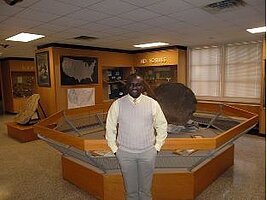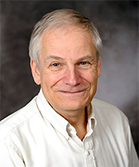Quantifying Phosphorus Cycling and Fate within an Abandoned Feedlot

Prosper Gbolo is a PhD Candidate in the University of North Dakota’s Harold Hamm School of Geology and Geological Engineering. Prosper Gbolo started his education in Ghana and continued at the University of Ghana, where he obtained a Bachelor of Science (BS) degree in Geology. He enrolled in the Ohio University’s Geological Sciences program to further his knowledge in surface and groundwater problems and how to manage those resources. In 2008, Prosper received a Master of Science (MS) degree in Geological Sciences at Ohio University. He worked with Professor Dina Lopez as a student researcher in the U.S. Environmental Protection Agency’s Science to Achieve Results (STAR) grant program. Prosper’s present research is focused on phosphorus transformation, mobilization, and sequestration within an abandoned cattle feedlot located in the Glacial Ridge National Wildlife Refuge near Crookston, Minnesota.
Email: prosper.gbolo@my.und.edu
Telephone: 701.741.4424
Fellow: Prosper Gbolo
Advisor: Phil Gerla, Ph.D., Associate Professor, Harold Hamm School of Geology and Geological Engineering, University of North Dakota.
Degree Progress: PhD in Geology and Geological Engineering; expected graduation in spring 2014.
Quantifying Phosphorus Cycling and Fate within an Abandoned Feedlot
Nutrients are very important chemical species that play important roles in soils, water, and living organisms, and are transformed from one species to another through different biogeochemical processes and cycles in different environments. Currently, there gaps that remain in our knowledge of the cycle, mobility, speciation, and sequestration of P in different environments. Nutrient quantification in runoff and nutrient leaching in groundwater systems has received attention recently. In view of this, Gbolo’s research will address the aspects of the P cycle within a heterogeneous beach ridge and wetland environment. This study will involve groundwater, soils, surface water, plants tissue, and microorganism analyses as part of a larger study to test the hypothesis that when P is transported by infiltration, it is sequestered and immobilized within natural sinks.
Project Objectives:
- Evaluate the phosphorus budget of the feedlot system
- Investigate the variability of some nutrients and trace elements associated with P immobilization
- Quantify the amount of phosphorus within the natural plant community and how important they can be for phytoremediation
- Determine the lithologic units in the area and the role they play in the transportation and sequestration of nutrients
Progress:
The project is in its final year. The site has been characterized using monitoring wells, nested wells, and soil pore water samples for groundwater nutrient monitoring. Grab and composite soil samples from various soil horizons and plant tissues have been sampled and analyzed during the 2012 and 2013 field season. Preliminary results of the groundwater have been published in the journal Hydrology and Earth System Sciences (HESS) and presently, the results of the soils and vegetation are in the final stage of review for submission.
Significance:
This research will bridge some of the research gaps concerning nutrient pathways in surface and subsurface systems, and the relationship between nutrients, organic matter, soil physiochemical properties, and some chemical species. Result of this research will have an implication for feedlot management and pollution control, and also help develop regulations for protecting surface and groundwater quality without placing undue hardship on animal production.
Conference/Presentation:
Gbolo, P., and Gerla, P., “Plants, soils, and waters’ role in mitigating environmental problems associated with an abandoned feedlot”, University of North Dakota Scholarly Forum (Grand Forks, 2014).
Gerla, P., Gbolo, P., and Gorz, K.L., “Large-Scale prairie restoration: managing for resilience”, Technical Report for the collaborative project between the Red Lake Watershed District, U.S. Fish and Wildlife, and the University of North Dakota (March, 2014).
Gerla, P., and Gbolo P., “Mapping the fate of nutrients at the abandoned Crookston Cattle Company feedlot”, North Dakota Water Quality Monitoring Conference (Bismarck, ND - March 2014).
Gbolo, P., and Gerla, P., “Using high-resolution, multispectral imagery to assess the effect of soil physical and chemical properties on vegetation reflectance at an abandoned feedlot (In-review, 2014)
Gbolo, P., and Gerla, P., “Nutrient variability in soils and plants in an abandoned cattle feedlot”, North Dakota /South Dakota Engineering Research Summit (Brookings, SD - April 2013).
Gbolo, P., and Gerla, P., 2013. Statistical analysis to characterize transport of nutrients in groundwater near an abandoned feedlot. Hydrol. Earth Syst. Sci. Discuss. 10:1553-1579.
Gbolo, P., and Gerla, P., “Assessing the Effects of Groundwater and Soil Nutrients on Vegetation Indices”, ND EPSCoR Conference, Alerus Center (Grand Forks, ND - 2012).
Gbolo, P., and Gerla, P., “Ground conditions and the fate of nutrients at the former Crookston Cattle Company”, North Dakota Academy of Science Meeting (Bismarck, ND - March 2012), and the University of North Dakota Scholarly Forum (Grand Forks, 2012).

Phil Gerla
Geology & Geological
Office: Leonard Hall Room 2013
81 Cornell Street Stop 8358
Grand Forks, ND 58202-8358
Telephone: 701-777-3305
Email: philip.gerla@UND.edu


